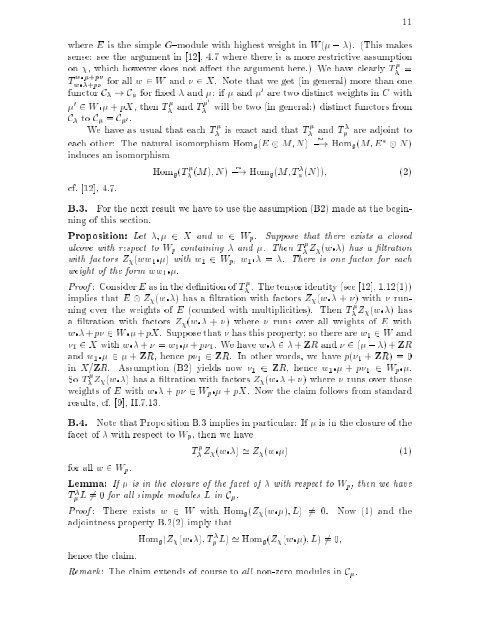subregular nilpotent representations of lie algebras in prime ...
subregular nilpotent representations of lie algebras in prime ...
subregular nilpotent representations of lie algebras in prime ...
You also want an ePaper? Increase the reach of your titles
YUMPU automatically turns print PDFs into web optimized ePapers that Google loves.
where E is the simple G{module with highest weight <strong>in</strong>W ( , ). (This makes<br />
sense: see the argument <strong>in</strong> [12], 4.7 where there is a more restrictive assumption<br />
on , which however does not a ect the argument here.) We haveclearly T =<br />
w +p<br />
Tw +p for all w 2 W and 2 X. Note that we get (<strong>in</strong> general) more than one<br />
functor C !C for xed and :if and 0 are two dist<strong>in</strong>ct weights <strong>in</strong> C with<br />
0 2 W + pX, thenT<br />
0<br />
and T will be two (<strong>in</strong> general:) dist<strong>in</strong>ct functors from<br />
C to C = C 0.<br />
We haveas usual that each T is exact and that T and T are adjo<strong>in</strong>t to<br />
each other: The natural isomorphism Homg(E<br />
<strong>in</strong>duces an isomorphism<br />
M;N) ,! Homg(M;E N)<br />
cf. [12], 4.7.<br />
Homg(T (M);N) ,! Homg(M;T (N)); (2)<br />
B.3. For the next result we have to use the assumption (B2) made at the beg<strong>in</strong>n<strong>in</strong>g<br />
<strong>of</strong> this section.<br />
Proposition: Let ; 2 X and w 2 Wp. Suppose that there exists a closed<br />
alcove with respect to Wp conta<strong>in</strong><strong>in</strong>g and . Then T Z (w ) has a ltration<br />
with factors Z (ww1 ) with w1 2 Wp, w1 = . There is one factor for each<br />
weight <strong>of</strong> the form ww1 .<br />
Pro<strong>of</strong> : Consider E as <strong>in</strong> the de nition <strong>of</strong> T . The tensor identity (see [12], 1.12(1))<br />
imp<strong>lie</strong>s that E Z (w ) has a ltration with factors Z (w + )with runn<strong>in</strong>g<br />
over the weights <strong>of</strong> E (counted with multiplicities). Then T Z (w ) has<br />
a ltration with factors Z (w + ) where runs over all weights <strong>of</strong> E with<br />
w +p 2 W +pX. Suppose that has this property; so there are w1 2 W and<br />
1 2 X with w + = w1 + p 1. Wehave w 2 + ZR and 2 ( , )+ZR<br />
and w1 2 + ZR, hence p 1 2 ZR. In other words, we have p( 1 + ZR) =0<br />
<strong>in</strong> X=ZR. Assumption (B2) yields now 1 2 ZR, hence w1 + p 1 2 Wp .<br />
So T Z (w ) has a ltration with factors Z (w + ) where runs over those<br />
weights <strong>of</strong> E with w + p 2 Wp + pX. Now the claim follows from standard<br />
results, cf. [9], II.7.13.<br />
B.4. Note that Proposition B.3 imp<strong>lie</strong>s <strong>in</strong> particular: If is <strong>in</strong> the closure <strong>of</strong> the<br />
facet <strong>of</strong> with respect to Wp, then we have<br />
for all w 2 Wp.<br />
11<br />
T Z (w ) ' Z (w ) (1)<br />
Lemma: If is <strong>in</strong> the closure <strong>of</strong> the facet <strong>of</strong> with respect to Wp, then we have<br />
T L 6= 0for all simple modules L <strong>in</strong> C .<br />
Pro<strong>of</strong> : There exists w 2 W with Homg(Z (w );L) 6= 0. Now (1) and the<br />
adjo<strong>in</strong>tness property B.2(2) imply that<br />
hence the claim.<br />
Homg(Z (w );T L) ' Homg(Z (w );L) 6= 0;<br />
Remark: The claim extends <strong>of</strong> course to all non-zero modules <strong>in</strong> C .

















